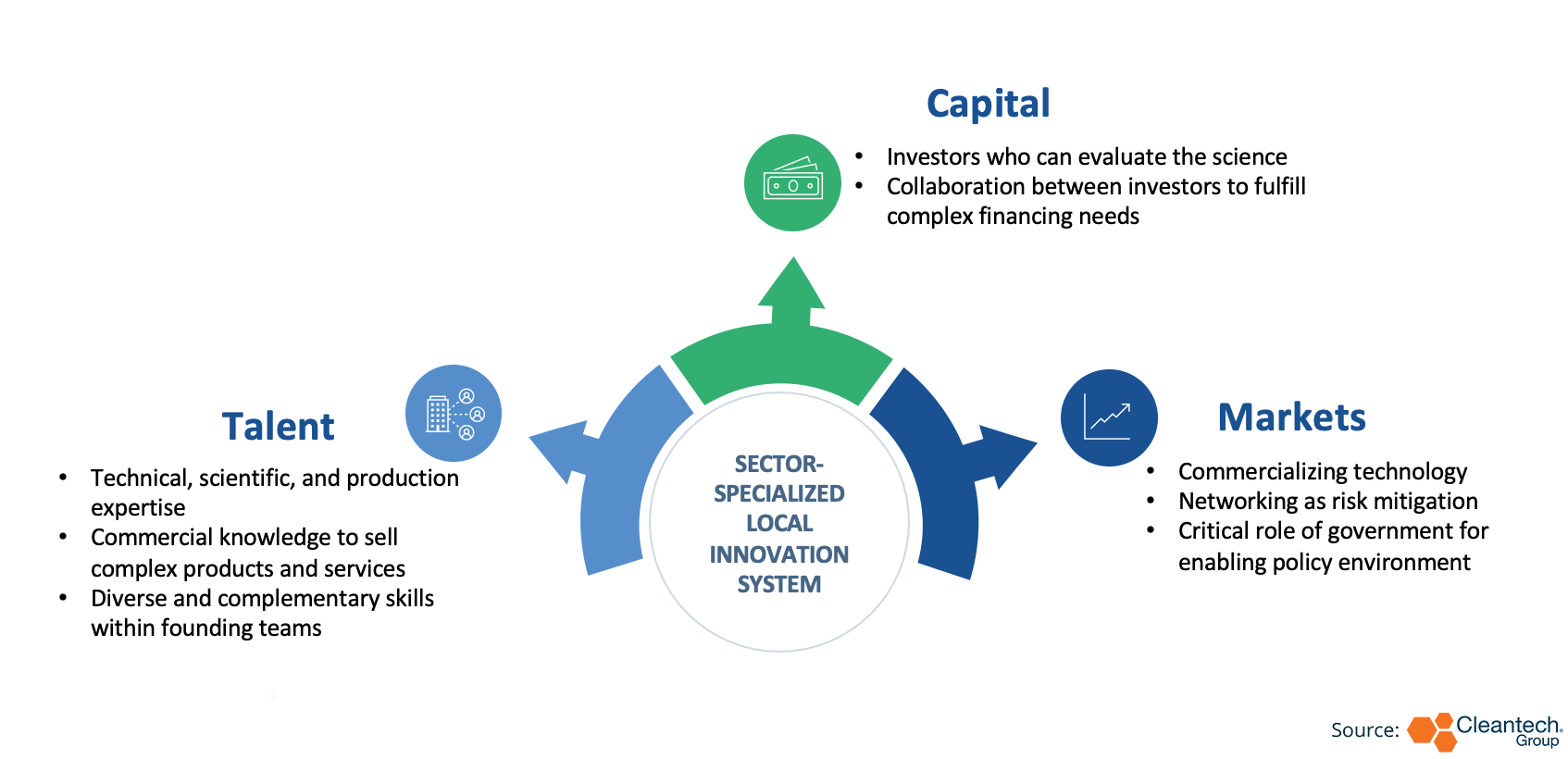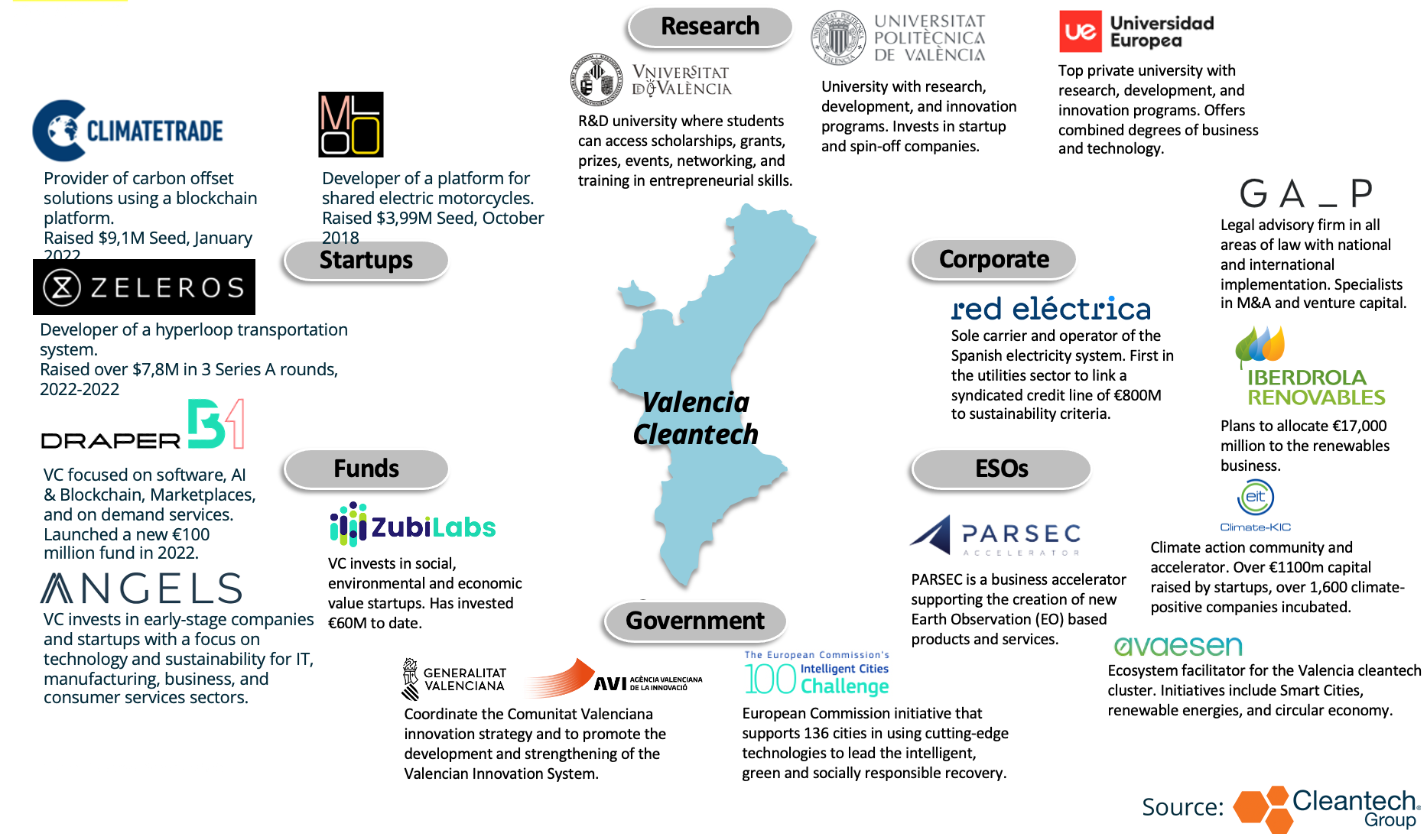In the dynamic landscape of cleantech innovation, clusters are catalyzing success. Impressively, start-ups in cleantech innovation clusters in the EU grew at a rate of 20% faster than start-ups outside of a cluster. So what are innovation clusters, and what makes them so successful at generating and scaling innovation?
The Unique Attributes of Cleantech Clusters
Cleantech innovation clusters are concentrated local ecosystems with a specific thematic focus on a subsector of cleantech, where local entities collaborate and network in close geographic proximity, usually within a city or region. Think open collaboration and sharing resources with other founders, investors, and potential clients to bring the innovation industry forward. Networking events, pitch days, and hackathons, a pipeline from universities to incubators and accelerators, and engaged government actors, stimulate cluster connectedness and vitality. If this sounds like an inspiring and motivating work environment, you’re right!
Key Ingredients: Talent, Capital, and Markets
In addition to the general scaling needs of high growth start-ups, cleantech innovation requires particular emphasis on three key ingredients: talent, capital, and market readiness. Cleantech innovation clusters facilitate access to specialized support for cleantech solutions: technical and commercial talent, risk capital and debt finance providers with expertise in evaluating technical solutions, and avenues to access new markets to commercialize new and disruptive products.

Cleantech clusters act as breeding grounds for start-ups and SMEs, accelerating growth through feedback loops and network effects between the key ecosystem actors: risk capital providers, corporates, incubators/accelerators, governments, and universities and the start-up ecosystem.
Clusters expedite growth potential as start-ups and SMEs quickly gain visibility, have more options for recruiting top-tier talent, and more opportunities to attract investors and meet potential clients. Some key outcomes of clusters are:
- Rapid creation of start-ups and SMEs
- Faster economic growth and job creation
- Bringing more innovation to market
- Exploiting regional strengths
- Unlocking public funding opportunities
- Responsive regulation across technology value chains
- Attracting private investments
Steps for Building or Accelerating Cleantech Clusters
While there is no one-size-fits-all formula for cluster success, certain actions have proven instrumental in their development. Here we will take you through the key actions to take at a local, national, and international level for building successful cleantech innovation clusters and accelerating start-up and SME growth.
The Role of Cluster Facilitators
Cluster facilitators play a pivotal role in driving cluster development. These facilitators, which may be Non-governmental Organization (NGOs), social enterprises, government, or hybrid organizations, provide services to ecosystem actors and collaborate with local and regional governments. In successful clusters, these facilitators act as intermediaries promoting networking, disseminating information on funding and commercial opportunities, and engaging in municipal-level advocacy to boost demand for cleantech solutions.
Geographic Concentration and National Strategies
Countries looking to develop cleantech clusters should consider national characteristics, objectives, strategic regions, and priority sectors within the cleantech domain.
In the U.S., Houston, TX is an example where synergies between key ecosystem actors are accelerating cleantech innovation. As a historical hub for the oil and gas industry, Houston is poised to emerge as a model for transitioning towards renewable energies and away from fossil fuels. The largest cleantech incubator in North America, Greentown Labs, opened its second location in Houston because of this promising opportunity.
The city has access to capital with accessible investors, project financing for start-ups, and corporate partnerships. Houston’s mayor is a co-chair on a bipartisan network of 450 U.S. mayors called Climate Mayors, leading the science-based, community-driven reduction of greenhouse gas emissions. Houston is unique in that many entrepreneurs come from corporations rather than universities.
Diverse Origins of Cleantech Clusters
Cleantech innovation clusters can emerge from various sources. Some arise within established innovation clusters, such as Boston, U.S., while others evolve from incumbent industries needing to decarbonize, like the Green Tech Valley in Graz, Austria. Local strengths and circumstances shape standout clusters, whether they are in areas with a high density of universities, a history of industrial expertise, or driven by national strategic priorities.
National-Level Support for Cluster Development
At the national level, governments can create conditions conducive to cluster development by implementing education and immigration policies to attract and retain talent, streamlining administrative requirements for young companies, and offering financial incentives like tax breaks and grants. A stable policy and regulatory framework that recognizes innovative solutions sends long-term market signals, attracting companies and investments. National branding also contributes to positioning the country as an attractive hub for cleantech innovation.
International Connections
Successful clusters are not confined by borders; they actively connect with international networks. Cluster facilitators contribute by providing information on international opportunities and eligibility criteria to local start-ups and SMEs. Moreover, facilitators from successful clusters join international networks to share best practices, fostering collaboration and connecting local innovators with global demand.
Cluster Close Up: Valencia
Valencia’s cleantech cluster was born as a group of renewable energy companies and has since generated commitment from universities, investors, and government. The cluster boasts:
- 300 public and private partners
- €450B in combined annual turnover business members
- 7,500 green jobs
- 275+ start-ups created
The keys to Valencia’s success as a cluster are its agility to transition and develop additional sectors, building the ecosystem from within via participatory leadership, a bottom-up approach to scaling, and attracting venture capital (VC) funding to the market with targeted partnerships in the region.

In short, the development of cleantech innovation clusters is a multifaceted process that requires a combination of local, national, and international efforts. With the right support systems in place, these clusters can become hotbeds of innovation, driving the cleantech industry forward and contributing to a sustainable future. As the world grapples with environmental challenges, the collaborative power of cleantech innovation clusters stands as inspiration for transformative change.
- SEO Powered Content & PR Distribution. Get Amplified Today.
- PlatoData.Network Vertical Generative Ai. Empower Yourself. Access Here.
- PlatoAiStream. Web3 Intelligence. Knowledge Amplified. Access Here.
- PlatoESG. Carbon, CleanTech, Energy, Environment, Solar, Waste Management. Access Here.
- PlatoHealth. Biotech and Clinical Trials Intelligence. Access Here.
- Source: https://www.cleantech.com/driving-cleantech-innovation-the-power-of-clusters/



